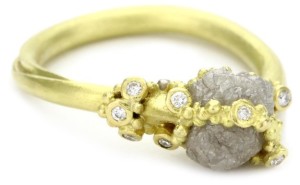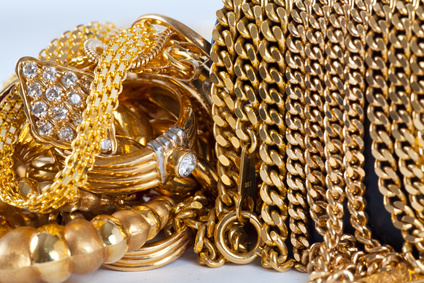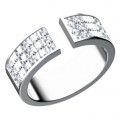What Is an Uncut Rough Diamond?
An uncut diamond is a stone that has not been shaped in any particular form by a professional cutter and has not undergone any polishing. Uncut diamonds are also referred to as rough diamonds (or raw diamonds).
Usually, after they are mined, those uncut diamonds whose quality is high enough to make them suitable for jewelry are sent to be cut by jewelry professionals.
Stones of lower quality are often used in industry because of their physical properties.
Why Is It Important for Diamonds to Be Cut and Polished?
Diamonds are cut and polished not only to make them look nicer and neatly shaped.
The way a diamond is cut determines its proportions, which in turn affect the way the stone will reflect light. This is important because diamonds that are cut with better proportions have more brilliance.
Polishing is also important for how brilliant a diamond will look. Generally, a polished surface lets more of the light that falls on it inside the stone, thus making it sparkle more.
Diamonds whose surface is rough block more of the light and look less brilliant.
Looking to sell your engagement ring or other diamond jewelry? Check out Worthy, which is an online jewelry auction platform — you can mail in your jewelry and let Worthy organize the sale for you, sending you the money after the piece is sold.
How Diamonds Are Cut
To understand the value of uncut diamonds, you should first understand how diamonds are cut.
In general, when a cutter looks at a rough piece of diamond, his or her goal is to cut it in such a way as to maximize the value of the resulting polished stone (or stones).
As you may already know, the value of a cut diamond depends on four main factors: how clear it looks, how colorless it is, how proportional its cut is, and how big the stone is.
With these value factors in mind, when given a piece of raw material, the cutter will try to cut one or more stones that are as clear of flaws as possible, while keeping each stone’s proportions as close to the ideal as practicable and making the resulting diamonds as big as possible.
It is often not possible to create a cut diamond that is perfectly clear, highly proportional, and big at the same time. This is why the cutter will often have to sacrifice one quality characteristic for another.
For example, a rough piece might be reduced in size in order to remove a portion containing visible flaws, thus increasing the diamond’s clarity grade. Or a stone might be cut with less-than-ideal proportions to maximize its size.
Tip: If you’re looking for cut loose diamonds, check out the diamond collection of James Allen.
What Determines the Value of Raw Uncut Diamonds?
Knowing how diamonds are cut and how polished diamonds are valued, we can take a look at what makes an uncut stone more or less valuable:
Clarity of Uncut Diamonds
As already mentioned, this characteristic refers to how many natural flaws there are in a diamond and how visible they are.
Uncut diamonds with few visible inclusions are more valuable than stones with many prominent flaws.
Color and Uncut Diamonds
Most mined diamonds have a yellow or brownish tint, and the stronger it is, the less valuable the stone is.
Diamonds with a less visible hue are more valuable. Colorless diamonds are very rare, and they command very high prices for this reason.
Carat of Uncut Diamonds
A diamond’s carat is a measure of weight (1 ct = 200 mg), and in general, bigger stones are more valuable since they are rarer.
However, rough diamonds of a higher carat are not always more expensive than smaller ones.
If a rough diamond has many visible flaws that will need to be cut out, its higher carat might not make it more valuable than a stone that is smaller but cleaner.
Higher rough carat weight does not always translate to higher carats when the piece is cut. One reason we already mentioned – the clarity of the piece also plays a part in pricing.
Another factor is the shape of the rough piece itself and whether it allows for a big polished stone to be cut out of it or the resulting stones are likely to be more in number but smaller. All else being equal, bigger diamonds cost more per carat than smaller ones when cut.
How to Identify Rough (Raw) Diamonds?
Rough diamonds look like transparent stones that are either colorless or tinted in yellowish or brownish color.
Actually, a very small percentage of rough diamonds are as colorless as the diamonds you can see in the jewelry store; most natural diamonds are tinted, and this is why the few white ones are so valuable.
You may read or hear about a lot of different methods to identify a real diamond.
The reality is, however, that most of them are unreliable.
There are many minerals that look like diamond and have very similar physical characteristics, and unless you are in an area where diamonds are mined, or you are a gemologist, you can never be sure that the transparent stone you’ve just found is the real thing.
The best and quickest way to identify a rough diamond is to test it with a portable diamond tester.
This device works by passing electricity or heat through the stone to detect its electrical or heat conductivity.
If you don’t have such a device and want to see if a stone you’ve found is a diamond, you can always go to a jewelry store and ask to have the stone tested (the service will usually cost you a small fee).
Can You Buy Rough Diamonds?
A lot of jewelry stores have begun to offer rough diamonds in addition to the cut and polished stones they sell. You can buy an uncut diamond either loose or mounted in a piece of jewelry.
So why buy an unpolished and uncut stone?
For one thing, rough diamonds are much cheaper than cut and faceted stones of similar color and clarity.
And let’s not forget that a rough stone will stand out when worn, as people are used to seeing mostly polished gems in jewelry.
The downside to buying a rough diamond is that its brilliance and sparkle will be much lower than those of a cut stone.
Why is that?
When a jeweler cuts a diamond, he or she shapes its facets so that the light entering it will be reflected by the stone’s walls, thus making the diamond look more brilliant and sparkly.
This effect is not present in uncut stones.
So, when deciding whether to buy a rough diamond, weigh its nonstandard look and low price against the relative lack of brilliance, and decide what is more important to you.
Where to Buy Diamond Jewelry?
We recommend James Allen (read review) because you can see a 360-degree video for any diamond before buying it.
Blue Nile is another reputable diamond retailer we recommend.
















